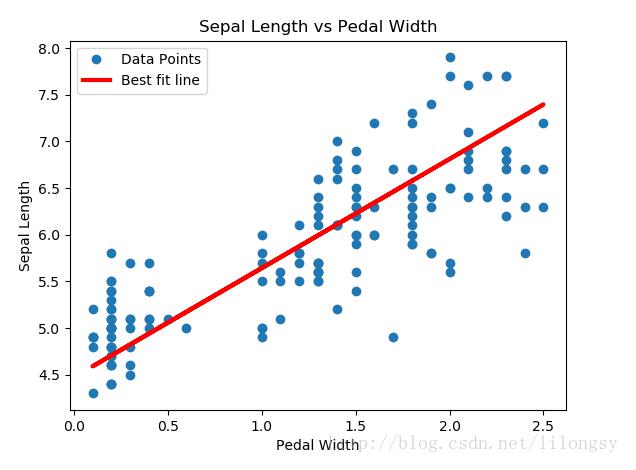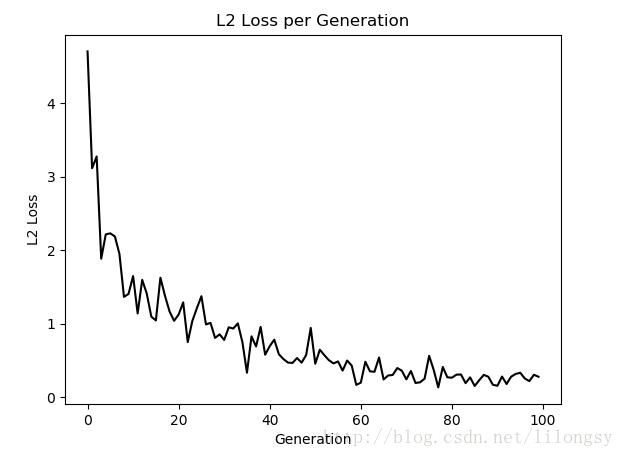本文将遍历批量数据点并让TensorFlow更新斜率和y截距。这次将使用Scikit Learn的内建iris数据集。特别地,我们将用数据点(x值代表花瓣宽度,y值代表花瓣长度)找到最优直线。选择这两种特征是因为它们具有线性关系,在后续结果中将会看到。本文将使用L2正则损失函数。
# 用TensorFlow实现线性回归算法#----------------------------------## This function shows how to use TensorFlow to# solve linear regression.# y = Ax + b## We will use the iris data, specifically:# y = Sepal Length# x = Petal Widthimport matplotlib.pyplot as pltimport numpy as npimport tensorflow as tffrom sklearn import datasetsfrom tensorflow.python.framework import opsops.reset_default_graph()# Create graphsess = tf.Session()# Load the data# iris.data = [(Sepal Length, Sepal Width, Petal Length, Petal Width)]iris = datasets.load_iris()x_vals = np.array([x[3] for x in iris.data])y_vals = np.array([y[0] for y in iris.data])# 批量大小batch_size = 25# Initialize 占位符x_data = tf.placeholder(shape=[None, 1], dtype=tf.float32)y_target = tf.placeholder(shape=[None, 1], dtype=tf.float32)# 模型变量A = tf.Variable(tf.random_normal(shape=[1,1]))b = tf.Variable(tf.random_normal(shape=[1,1]))# 增加线性模型,y=Ax+bmodel_output = tf.add(tf.matmul(x_data, A), b)# 声明L2损失函数,其为批量损失的平均值。loss = tf.reduce_mean(tf.square(y_target - model_output))# 声明优化器 学习率设为0.05my_opt = tf.train.GradientDescentOptimizer(0.05)train_step = my_opt.minimize(loss)# 初始化变量init = tf.global_variables_initializer()sess.run(init)# 批量训练遍历迭代# 迭代100次,每25次迭代输出变量值和损失值loss_vec = []for i in range(100): rand_index = np.random.choice(len(x_vals), size=batch_size) rand_x = np.transpose([x_vals[rand_index]]) rand_y = np.transpose([y_vals[rand_index]]) sess.run(train_step, feed_dict={x_data: rand_x, y_target: rand_y}) temp_loss = sess.run(loss, feed_dict={x_data: rand_x, y_target: rand_y}) loss_vec.append(temp_loss) if (i+1)%25==0: print('Step #' + str(i+1) + ' A = ' + str(sess.run(A)) + ' b = ' + str(sess.run(b))) print('Loss = ' + str(temp_loss))# 抽取系数[slope] = sess.run(A)[y_intercept] = sess.run(b)# 创建最佳拟合直线best_fit = []for i in x_vals: best_fit.append(slope*i+y_intercept)# 绘制两幅图# 拟合的直线plt.plot(x_vals, y_vals, 'o', label='Data Points')plt.plot(x_vals, best_fit, 'r-', label='Best fit line', linewidth=3)plt.legend(loc='upper left')plt.title('Sepal Length vs Pedal Width')plt.xlabel('Pedal Width')plt.ylabel('Sepal Length')plt.show()# Plot loss over time# 迭代100次的L2正则损失函数plt.plot(loss_vec, 'k-')plt.title('L2 Loss per Generation')plt.xlabel('Generation')plt.ylabel('L2 Loss')plt.show() 
